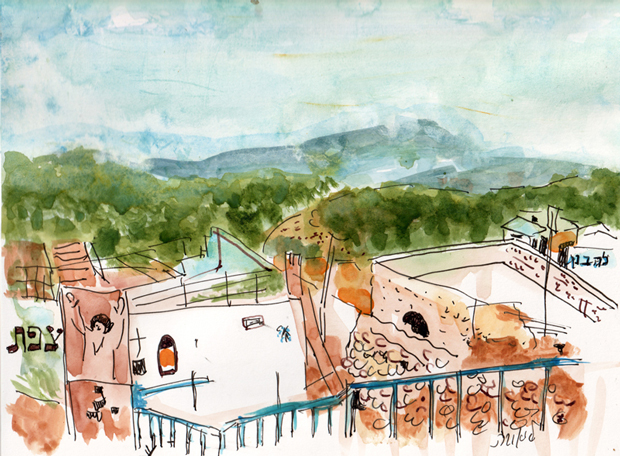
Have you ever been to a paint night? What did you paint? Was it a learning experience, or were you just given some paints and told: “here ya go.”
This past year I was privileged to host two paint nights. For the first one, I did a slide show. I showed perspective, a value study, and a possible finished project. I got feedback later: “I wanted more instruction.”
So when I had the opportunity to host a paint night for a smaller crowd recently, I decided to teach people one on one or in small groups. I publicized the paint night with a poster; I painted the Tsfat or Safed scene that I photographed years ago as a border. The materials given out were acrylic paints, not the sort of paints I have used much. I handed out pencils and some paper, and I showed the participants how to divide up the page into parts, so what they thought was a difficult subject became easier to handle. I pointed out the natural mountains at the top of the scene and the architectural, man-made elements below. Some chose to just paint the mountains. A few tackled the whole scene and did both. Others just played with the paints and chatted with their friends.

This was my first attempt at a border for advertising the paint night. I made the white too small.

So I painted again, and this one became the border for the details of the paint night.
At the top of this post is a watercolor that I painted from the Tsfat or Safed scene that I chose as the subject for the paint night. Since there has been a lot of upsetting news coming from Israel lately, we went with an Israeli theme for the paint night.
Due to the disheartening news, I decided to post a subject that was Israeli but warmer in nature. I revisited a photograph that I had taken years ago of Yemin Moshe, an old, elegant neighborhood outside of the Old City of Jerusalem. I did an interpretation in gouache:

Getting back to posters, I have been publicizing a series of talks by our local rabbi. Each one is a “parshat hashavua” or Torah portion of the week. For each poster I read the Torah portion well in advance and look for visual ideas that I can put in a poster. In the Torah portion of Hayei Sarah, Rebecca feeds not only Eliezer but also his camels. Camels! I took out children’s books about camels from the library, and I had fun drawing and painting a few camel scenes.
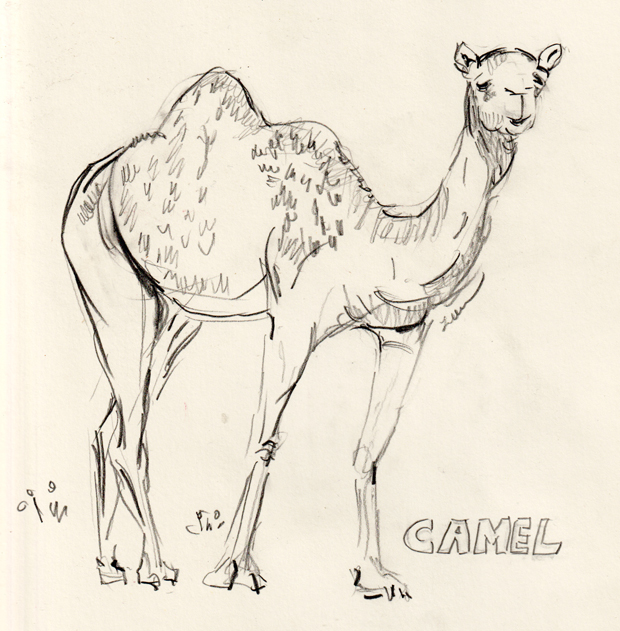
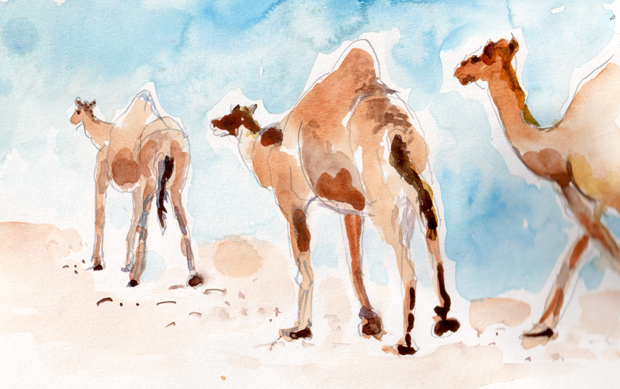
Back to paint night: I have two ideas for upcoming ones:
- Teach how to mix a palette of hue, tint, shade (color, lighter version of that color, darker version of color). Start with a blue, red, and a yellow (primary colors).
- Only black: only allow black for the first half an hour. Then they get treated to pink, turquoise, and lavender/purple.
The inspiration for the only black paint night was a participant wanted some black paint. I had left out the black paint on purpose, so students would mix their own darks. It got me thinking: how could we make good use of black? Using only black would force the students to think about darks and lights. Am I being too strict?
What would you want to learn at a paint night?
If you want to purchase one my painting as a print, visit the store.
If you want to subscribe, sign up for the mailing list.
Autumn: what comes to mind? Oranges, yellows, and deep reds. Colorful leaves, first on the trees, fall down and scatter the streets with their inviting hues.
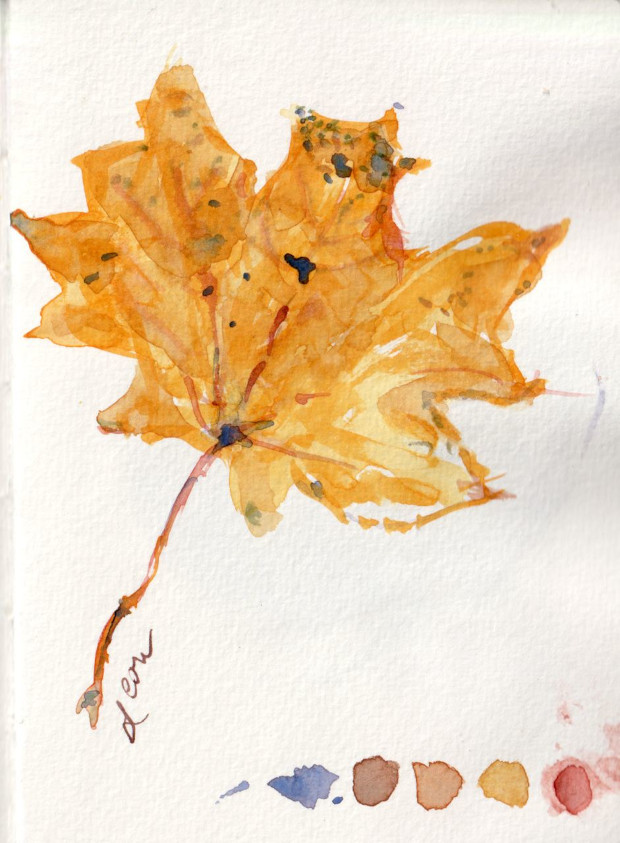
I was walking outside. I saw this leaf. I picked it up and put it on my dining room table, next to my watercolor paints and brushes. A day or two later, this painting emerged.
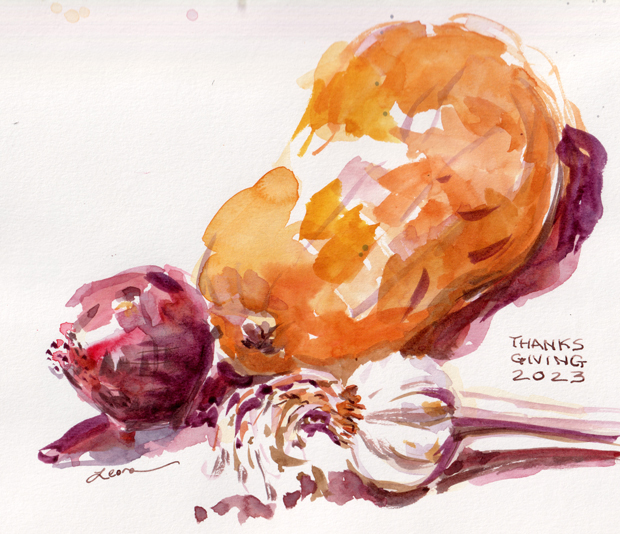
Thanksgiving is a time for family, food, and more of those mustard-y, yellow, orange, and red hues. I had a butternut squash in my kitchen. Nearby was a purplish red onion. They called to me. I buy plenty of garlic from a farmer at the Highland Park Farmers Market, so I added it to the still life. It was nice to take time to paint, as the next week I only had time to cook!
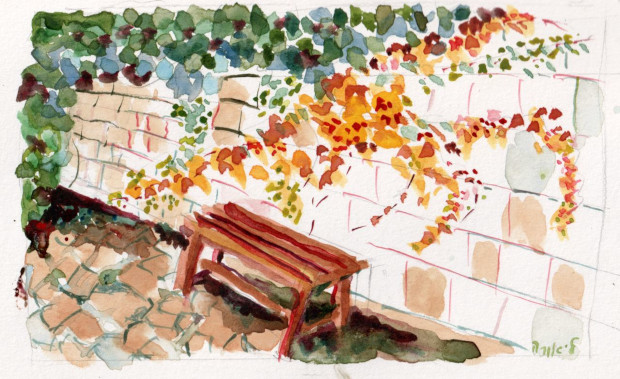
Autumn in Jerusalem is more subtle. Snow is rare; cold rain is what one can expect, in a good year that has no drought. My friend Ahuva Bokow photographed a beautiful scene of a bench by a wall with colorful ivy. I decided it would be the perfect end to this post on autumn colors.
Unlike summer for the rest of the world, summer in the Jewish calendar is a time of sadness. In the month of Tammuz, we remember the siege of Jerusalem. In the month of Av, we mourn the holy Temple, the Bait HaMikdash, that was destroyed not just once but twice. There is a custom not to listen to music during the three weeks between the 17th of Tammuz (siege of Jerusalem) and the 9th of Av (destruction of the Temple).
Painting Music
By the 15th of Av, however, the sadness turns to joy. One of the ways humans experience joy is listening to music. I was fortunate to attend not one concert but two concerts around that time. Rugburn, a band that plays jazz, funk, and rock music, held a concert in local Donaldson Park, so I had a great time not just drawing the musicians’ movements but also adding in the surroundings. The Imperial Band of South River plays pop and classical music in the Imperial Music Center of South River; a friend plays with the Imperial Band each month, and I finally had a chance to attend, drawing pad and Uniball pen in hand.
For both concerts I took my drawing notebook. I did quite a few drawings of the musicians. In fact, I paid more attention to the bodily swaying of the musicians that I did the notes that came out of the musical instruments.
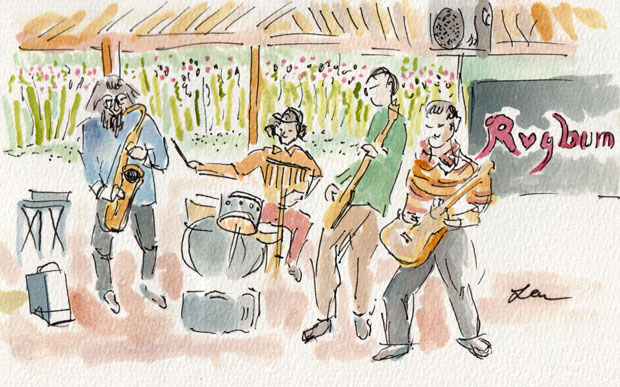
My favorite from Rugburn is this one with the four players swaying to the music and the beautiful reeds and grasses of Donaldson Park swaying in a variety of colors in the background.
You can see more in the art database: https://www.leoraw.com/artcat/rugburn/
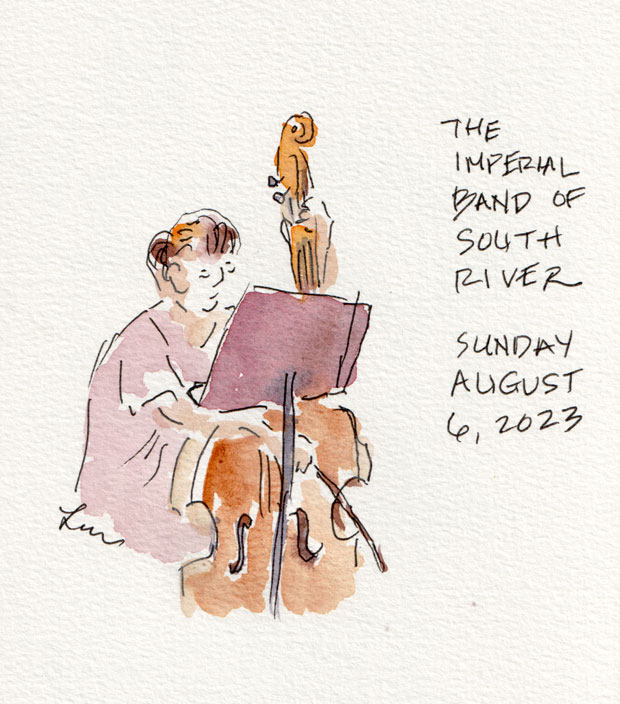
I really like the bass player from the Imperial Band. You can see more of the Imperial Band in the art database.
Preparing for Yom Tov
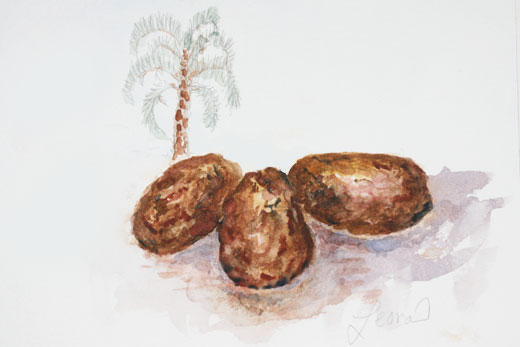
So far, most of my preparation for Yom Tov (holidays) is in my head. I plan to do a Rosh Hashana dinner with as many simanim as I can prepare. Above is a painting of Dates in Front of Palm Tree, watercolor on paper, 2011. Maybe next week I will do a painting of Elul, the Jewish month before Rosh Hashana, which is a time of preparation and asking for forgiveness.
An Art Database
One of the reasons I created an art database is so when potential clients can ask: what works can I buy as prints? I can point to the art database or to a specific category such as Raritan Avenue.
I placed my first order of giclée prints for a client this past week. Giclée is the recommended way to produce archival reproductions of fine art. She had saved screenshots of her favorites my work from the past few years. In the future, I will say to a client: browse through the art database! That’s where one can find illustrations that will work well as prints.

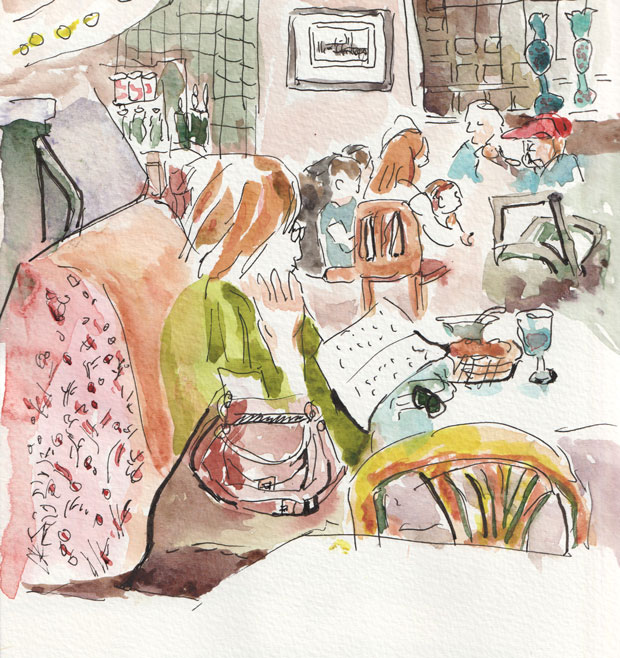
My favorite restaurant is the Bridge Turkish & Mediterranean Grill (kosher) on Raritan Avenue in Highland Park, New Jersey. The staff makes me feel at home. The decor, inside and outside the restaurant, welcomes a painter — there is so much to paint! And I enjoy my food.
I asked a few friends: Have you eaten at the Bridge Restaurant in Highland Park? What is your favorite dish? Can you tell me what you like about the restaurant?
Here are the responses. I interspersed paintings of the restaurant:
“The food is always fresh and flavorful, the staff is very friendly and accommodating. Always a great experience. Favorite food: doner kebab. And the rice on the side is amazing.”
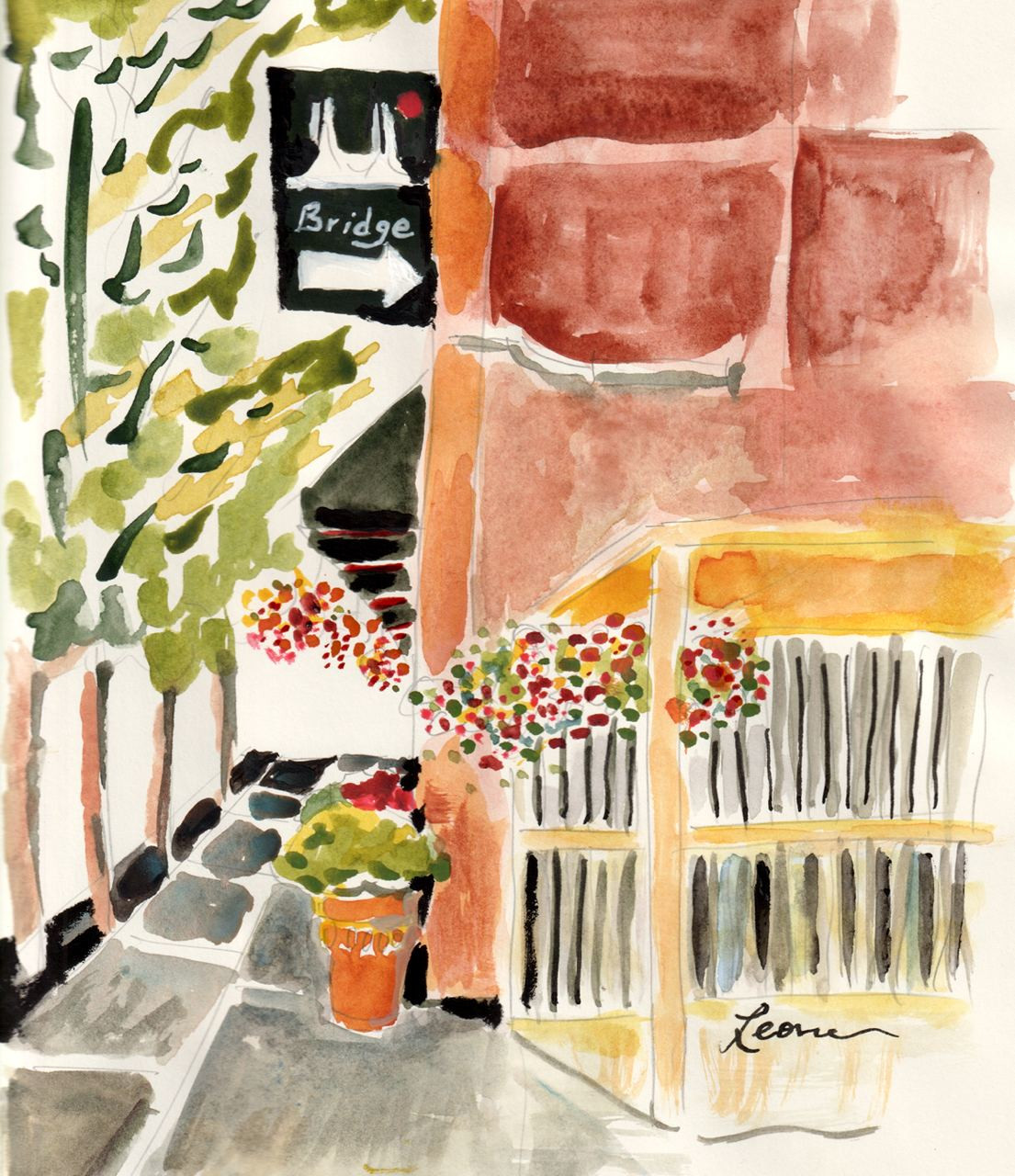
“Always consistently good! they allow you to enjoy your meal–you never feel pressured to rush. Friendly service and knowledgeable wait staff.”
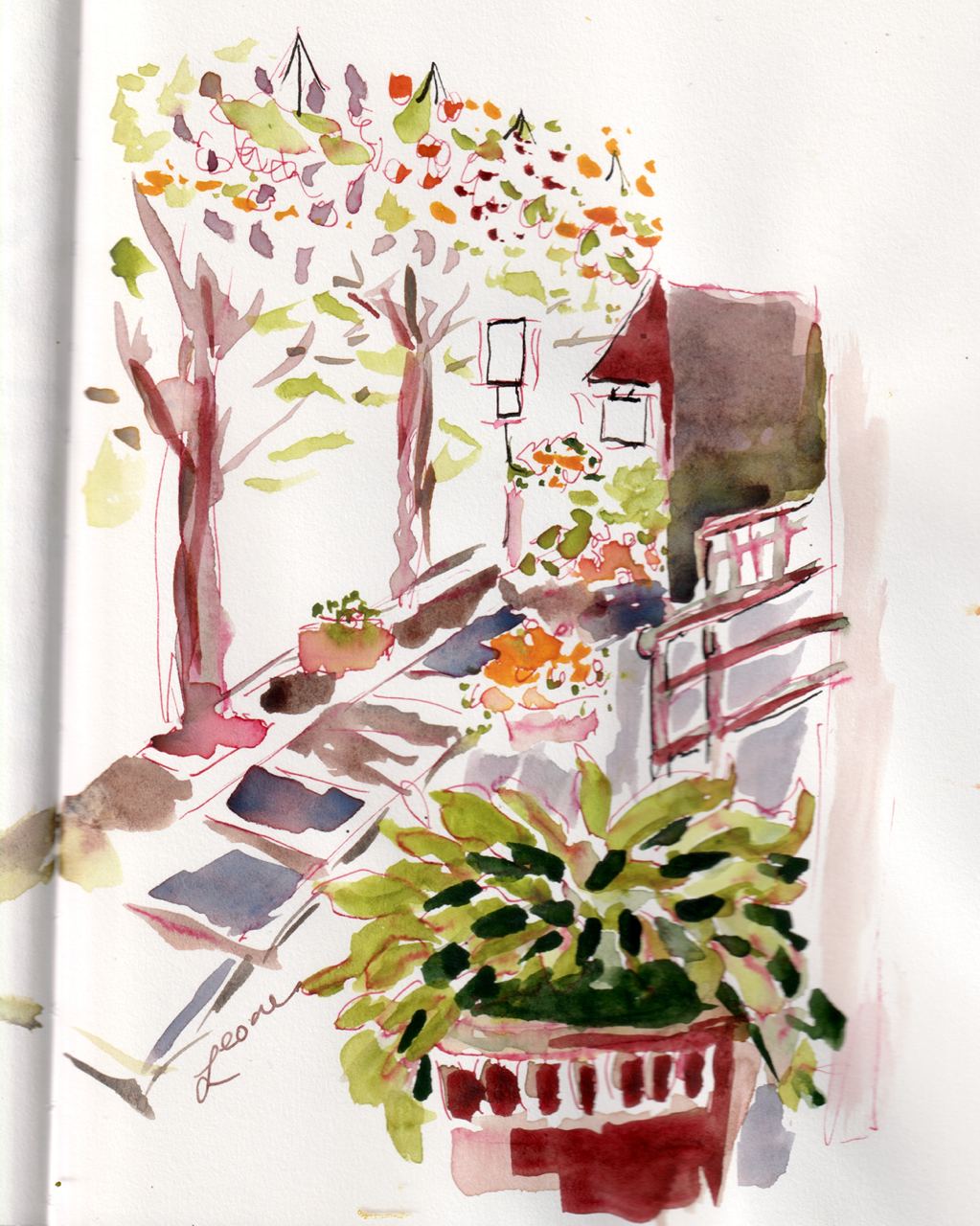
“The food is always fresh, at the right temperature. The staff does not try to rush you and the decor is absolutely perfect…”
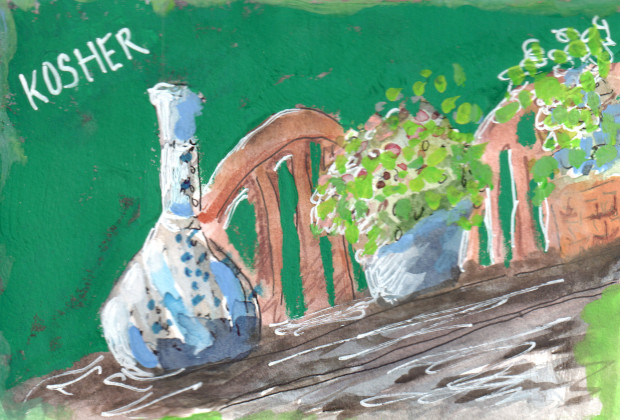
“I particularly enjoy the lentil soup, Mediterranean salad, tahini and their bread is amazing!”
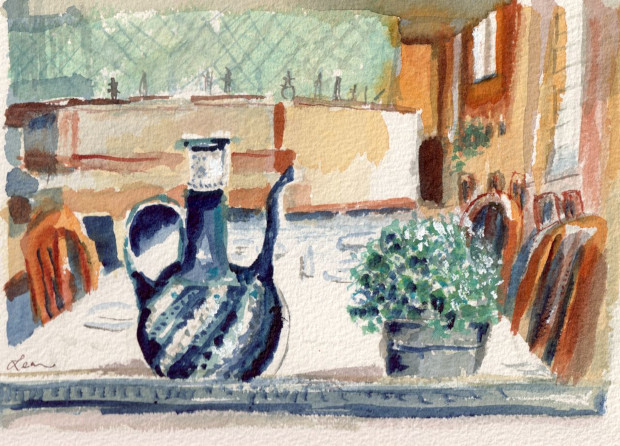
“Love the stuffed roasted eggplant! Rice is amazing! Love the decor: all the vases, plates, etc. Love being greeted by Michael Garber!”
I hope you enjoy this series of paintings and sketches that I have done of the restaurant.
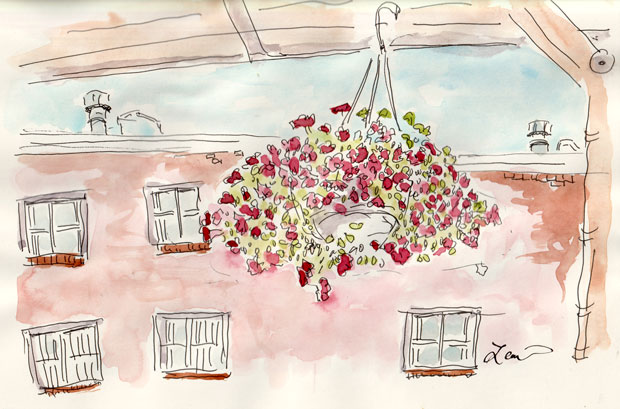
Outside the restaurant there is a little booth where one can be served and eat the delicious food. The hanging flowers are attractive and warm my heart.
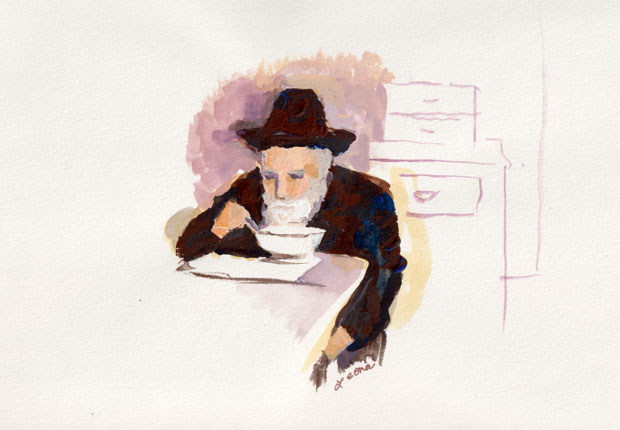
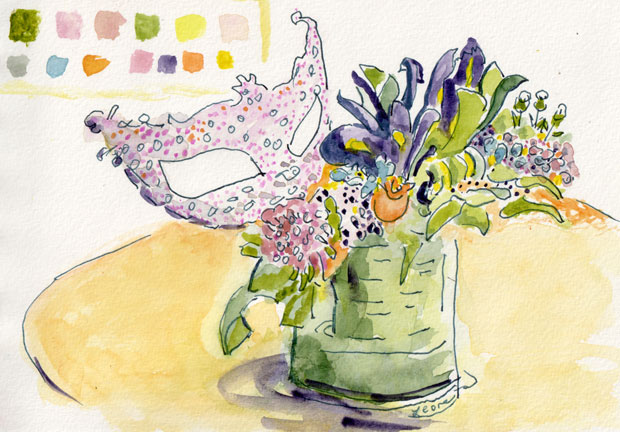
I painted the bouquet of flowers (note the purple irises and the mask) that I bought from Roberts Florals in Highland Park, New Jersey on Purim. My guests enjoyed the bouquet along with the meal. I am relatively pleased with the result of the painting.
My current ultimate goal is to get better at painting portraits. I am confident in my flower painting abilities. I could improve in details, but I do not strive to be a realistic floral artist. One reason I chose to paint the bouquet is it was a good warm up to painting after Shabbat and after a week of little painting in general.
Why I failed miserably at 100 people week
Early in March there was a competition to draw or paint 100 people in a week. My start was delayed by Purim; I had lots of preparations to do for the holiday, and guests showed up to entertain us at our seudah (festive meal). Finally, I went out one day with my sketchpad and doodled quite a few people. I did not care much for the result, so it is not getting posted here. Then I ran out of time to go outside and look for people. So I went up to my attic late one night, and I took down several photos of people that I found inspirational.
How 100 people week Inspired Portraiture Adventures
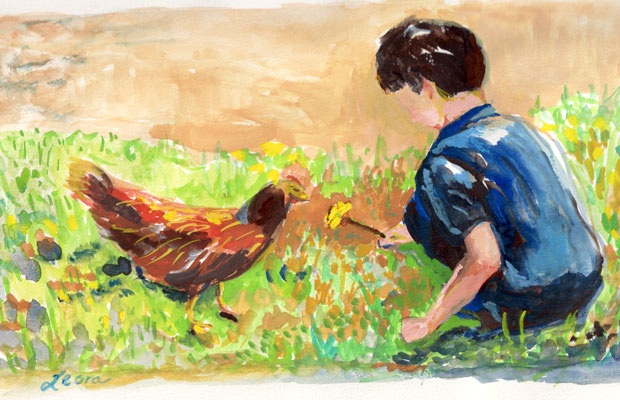
One of the photos that I found was one of my sons showing a dandelion to a chicken. I did one quick sketch; the proportions of the head were off. I started another. I continued painting into the night, and I am please with the result: gouache media, lots of strokes and movement. I like how the light falls on the figures and the variety of hues established.
Here is another portrait that I did, from an old black and white photo of a relative eating soup. This portrait is also done with gouache. Maybe I will do another version in the future with more attention to the background.

More Flowers to Show
Whenever I go shopping with a certain friend, I am done long before she is. No problem! Each store seems to have a section of flowers. So I put my paid groceries in the car, and I return to draw with a Uniball pen whatever strikes me in the store. Often, the flowers stand out. Here are a few of my favorites:
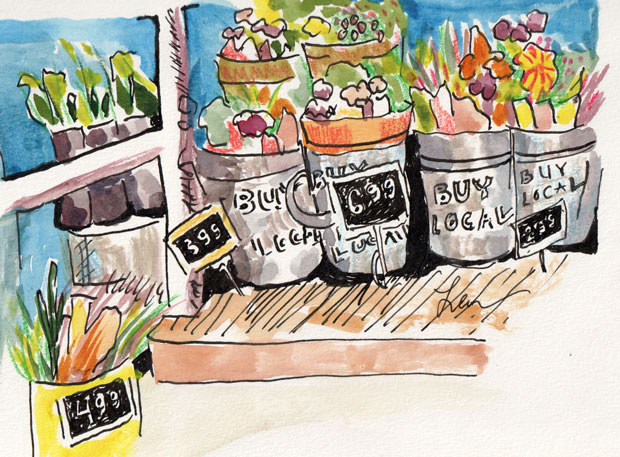
This one was painted after another one that had the brand name of a large chain store got rejected from an online shop that sells artists’ goods. Lesson learned: buy local flowers. Advertise local stores. No need to ruffle the feathers of any large chain stores.
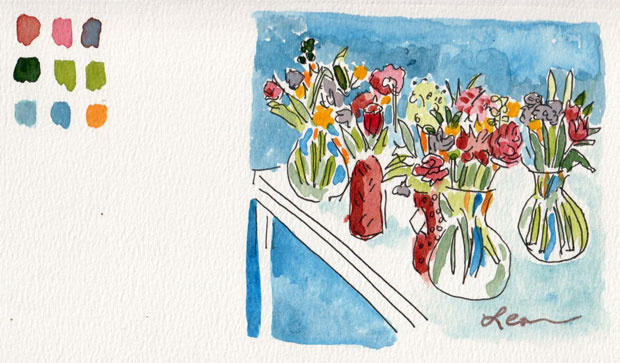
I often like painting a palette of colors near my watercolors. This palette compliments the flowers nicely, organic flowers shapes near geometric squares.
More on Painting Flowers
I am reading Painting Flowers in Watercolor with Charles Reid, a classic in the watercolor book world. Two ideas that I look forward to incorporating in future watercolor floral sketches or paintings:
1) Pay attention to negative shapes that the flowers make almost as much as to the flowers themselves. Do not overwork the details. Paint the background along with painting the flowers. The background should not be an after thought.
2) When painting the background, don’t do one solid expanse of one color. Do a variety of color in a mix that compliments whatever flowers one is painting.
Charles Reid uses a lot of cadmiums in his palette (Cadmium Yellow, Cadmium Orange). I will substitute colors in my palette, probably Hansa Yellow (light, medium, or dark) and New Gamboge. One exercise is to paint daffodils. Another is techniques for white flowers. Daffodils and magnolias are in bloom now. Hopefully, I will be able to experiment with his ideas.
It is now the Jewish month of Nissan. In Nissan we celebrate freedom on Passover. We are also commanded to say blessing on a fruit tree when it shows its first blossoms. I will be looking around my neighborhood for all kinds of blossoms for blessings and for sketches.

Urban Sketching at the Tip of the Triangle
Do you think you need to visit New York City or Philadelphia to do urban sketching? Think again. I have found inspiration within a short walk of my home. One could define urban sketching as visual storytelling with a notebook and pens, pencils, paints, or any other artistic media.
Highland Park has an area called The Triangle. It is mostly residential, but it does host a large elementary school. I live by the tip, which holds a small statue of a Doughboy. The Doughboy, a slang term for a U.S. infantryman, is a symbol of veterans who fought in wars. The initial name came from World War I. It was erected in 1921. A new version of the Doughboy statue went up in Spring 2022, after a car or a truck supposedly ran it over. There were theories that it actually was hidden by the good guys when the bad guys were taking down historic statues.
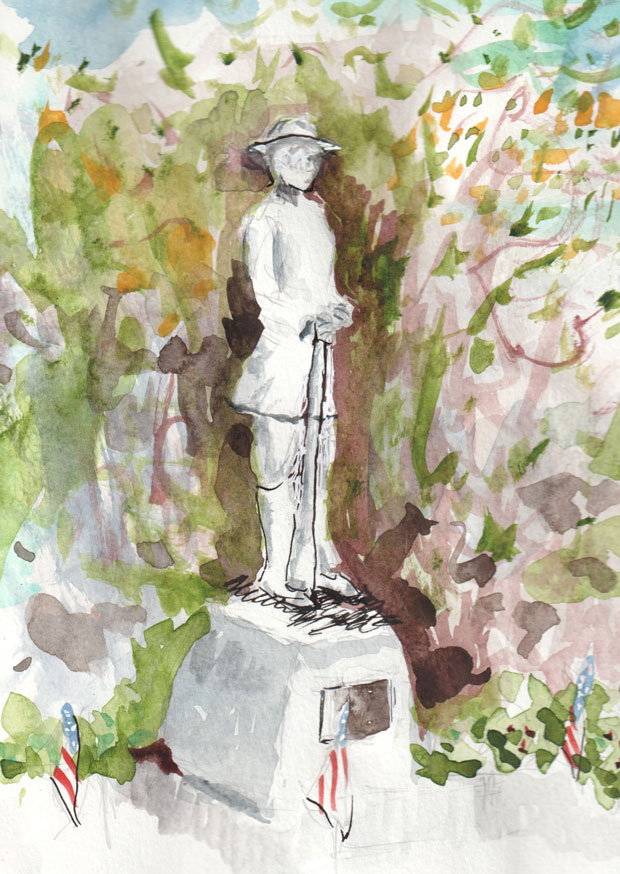
I did this painting of the Doughboy almost two years ago. It is not easy to paint a statue. There are no local hues other than off-whites. And there is a lot going on at the bottom: legs, a rifle, a big rock. After a few early attempts, the main thing I learned was to slow down while doing the drawing. Get the proportions right, and leave ample white space.
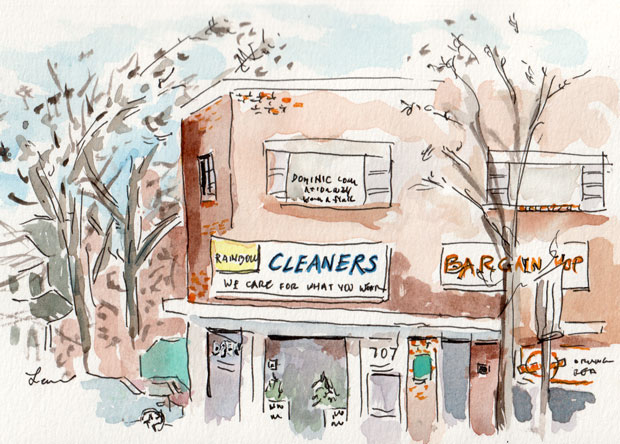
The incentive for doing Rainbow Cleaners is that the store got a new owner. The store is right down the block, so it is an easy “commute” to work on this subject. I like all the signs on the building. There are oranges courtesy of the Bargain Shop and a bright green parking sign. Our family lawyer has his office upstairs.
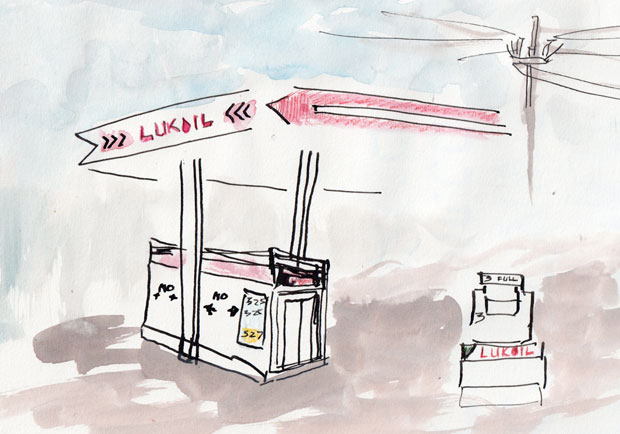
I haven’t done much with Lukoil yet. It has that lovely shade of red in its logo. I often fill my car with gas here. One day one of the gas attendants told me I dropped my gloves after I finished sketching. His kindness gives me a warm feeling about a gas station!
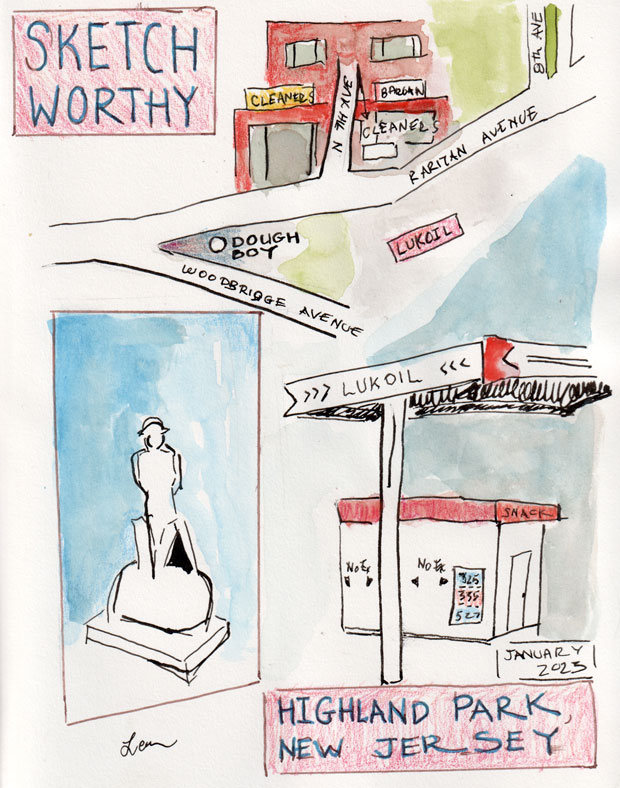
This is a sketch that I did as part of a class called Sketching Now Sketchbook. It has a map of the tip of the Triangle and the positions of the Doughboy statue, Rainbow Cleaners, and the Lukoil gas station. Each one is down the block from my home, so good spots for me to visit when I feel like doing some local urban sketching.
Visit the leoraw store
If you made it this far in reading this blog post, please check out my new store. You can purchase a Highland Park High School sketch on a clock, dinner at the Bridge Turkish restaurant on a mug, a t-shirt of peaches at the Farmers Market, and more.
Still in the planning stages: a database of my paintings and sketches, so it will be easier for potential clients to look up works of mine that they like. For example, if you type in ‘doughboy’ you will get a listing with images and links of my paintings or drawings of the Highland Park Doughboy.

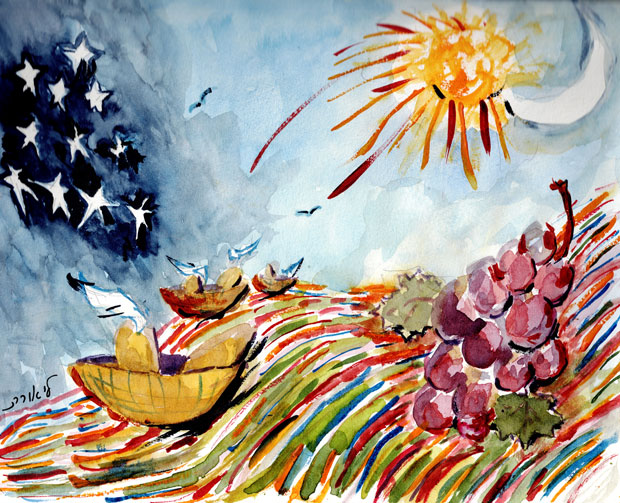
I succeeded in making illustrations for each of the parshiot (section of Torah read in the synagogue each week) of Breishit (Genesis) this past fall. However, only a few illustrations became blog posts.
I had a great time redoing an illustration for Parshat Vayeshev, the parsha that has Joseph’s dreams along with the dreams of the butler/cupbearer and of the baker.
“I have had another dream: And this time, the sun, the moon, and eleven stars were bowing down to me.” — Genesis 37:9
On the vine were three branches. It had barely budded, when out came its blossoms and its clusters ripened into grapes. — Genesis 40:10
In the uppermost basket were all kinds of food for Pharaoh that a baker prepares; and the birds were eating it out of the basket above my head.” — Genesis 40:17
The stripes of Joseph’s coat, not part of a dream but part of the parsha, felt like I was painting a roller coaster.
Jacob’s Ladder, a work on paper done in gouache, is one of my favorites. In creating the painting Jacob’s Ladder, story found in Parshat Vayeitze, I looked at Renaissance and more recent paintings for inspiration. The man lying down was actually inspired by a relative napping on a couch. He made a convenient model for the painting.
He had a dream; a stairway was set on the ground and its top reached to the sky, and angels of God were going up and down on it. — Genesis 28:12-13
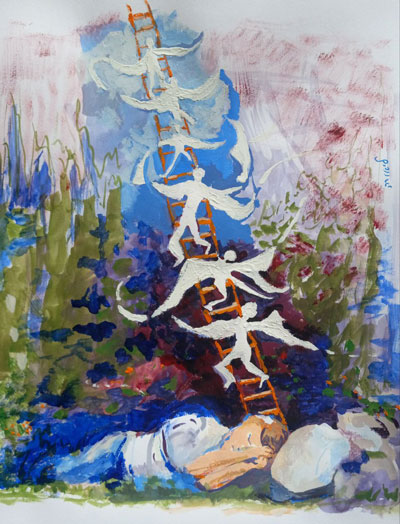
I set up a store so I can sell reproductions of my art work. There are two options: for those who want fine art productions they can hang proudly in their homes, I am offering prints of painting such as Jacob’s Ladder and Joseph’s Dreams for limited times with limited prints. One will need to contact me directly to get a fine print. For those who like mugs or tote bags with Highland Park illustrations, visit the online shop (click on any image to get to more products). Buy as many of those as you want!

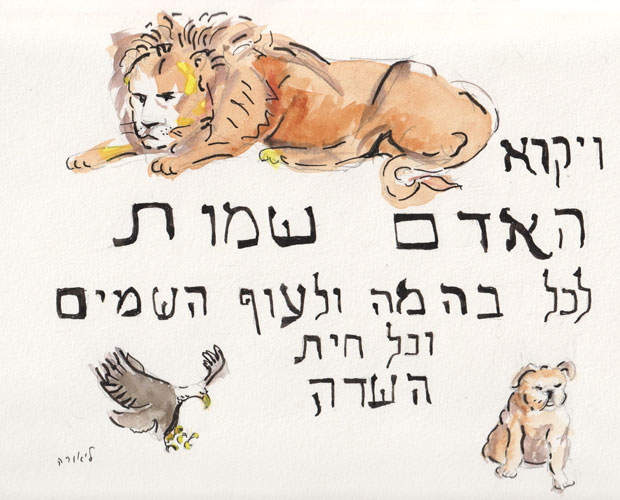
One of my problems with blogging is coming up with text. When I used to use SEO tools (search engine optimization), they would say “you need 500 words or so to be” blah blah blah, something about meriting a golden spot in some grandstanding search engine. Well, if words are needed, here are some words.
A new year begins … we ended the fall holidays of Rosh Hashana, Yom Kippur, Sukkot, Shemini Atzeret, and Simhat Torah. The Jewish year of 5783 has begun. I am hoping to do a little more blogging this fall … Learn How to Ferment (or whatever I will choose to name the post) is almost for publishing. Other blog ideas: How to See In Order to Draw Better. Highland Park Synagogues in Watercolor or Gouache. Highland Park Restaurants. Local Park Scenes. Not all of these will make it to production … but maybe one or two will.
Each week I aim to make an illustration for the parsha (portion of the Torah read in the synagogue on a weekly basis). For Breishit, the first parsha of the year I depicted (Genesis 2:20):
And Adam gave names to all the cattle and to the birds of the sky and to all the wild beasts;
וַיִּקְרָ֨א הָֽאָדָ֜ם שֵׁמ֗וֹת לְכׇל־הַבְּהֵמָה֙ וּלְע֣וֹף הַשָּׁמַ֔יִם וּלְכֹ֖ל חַיַּ֣ת הַשָּׂדֶ֑ה
Why did I choose the pasuk (sentence) about Adam naming the animals? I just liked the idea Adam gave out names. It was opportunity to draw an elephant. Except the elephant did not make it into the finished illustration. Lion is King of the Forest. So Lion is on top. Eagle is a majestic bird, so it got the bird spot. And bulldogs are cute.
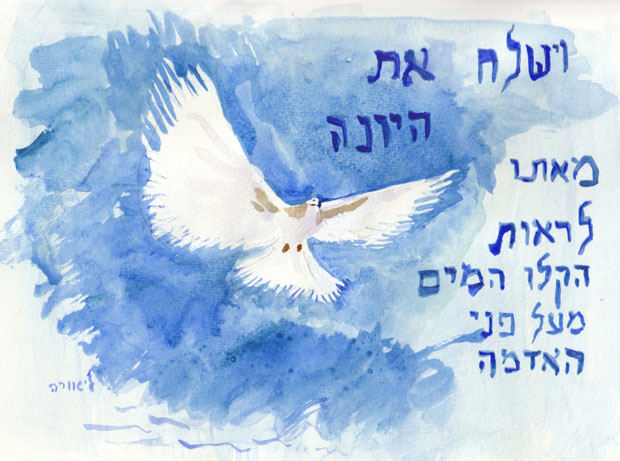
After Breishit, the parsha is Noah. I get a little help each week from Rabbi Avigdor Bonchek, author of the What’s Bothering Rashi series.
I chose to illustrate the dove in the story of Noah because of a Rashi about this pasuk (sentence) (Genesis 8:8):
וַיְשַׁלַּ֥ח אֶת־הַיּוֹנָ֖ה מֵאִתּ֑וֹ לִרְאוֹת֙ הֲקַ֣לּוּ הַמַּ֔יִם מֵעַ֖ל פְּנֵ֥י הָֽאֲדָמָֽה׃
Then he sent out the dove to see whether the waters had decreased from the surface of the ground.
Who was supposed to see if the waters had subsided? Noah or the dove? It was Noah. If the dove did not come back, then there was land for the dove. If she found a resting place, the yonah (dove) would not return.
Before the dove, Noah sent out a raven. Maybe next year I will paint a raven.
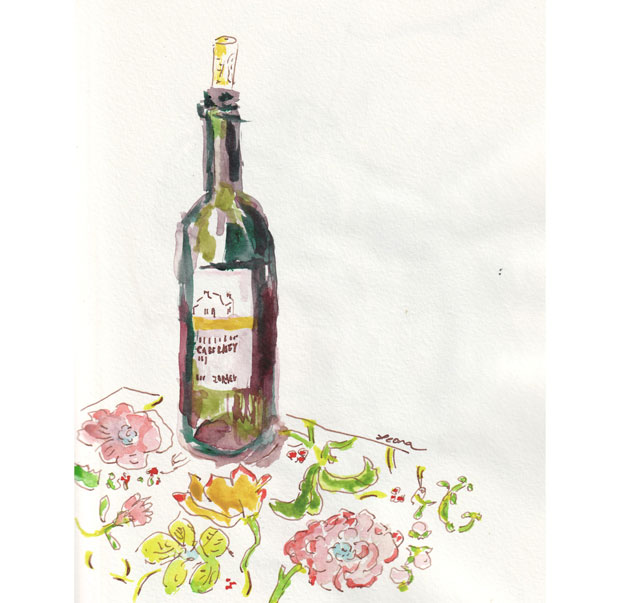
What is the motivation to choose a subject to paint? Why pick one object over another? Why would someone paint a particular person? I think the answer to all of these questions is emotional attachment. If you feel good or expect good feelings from painting a chosen object or person, you are more likely to enjoy the painting process and not feel like it is a task.
Why did I enjoy painting this wine bottle? I liked the looseness that I applied to the bottle. I also had fun with the patterned fabric underneath it.
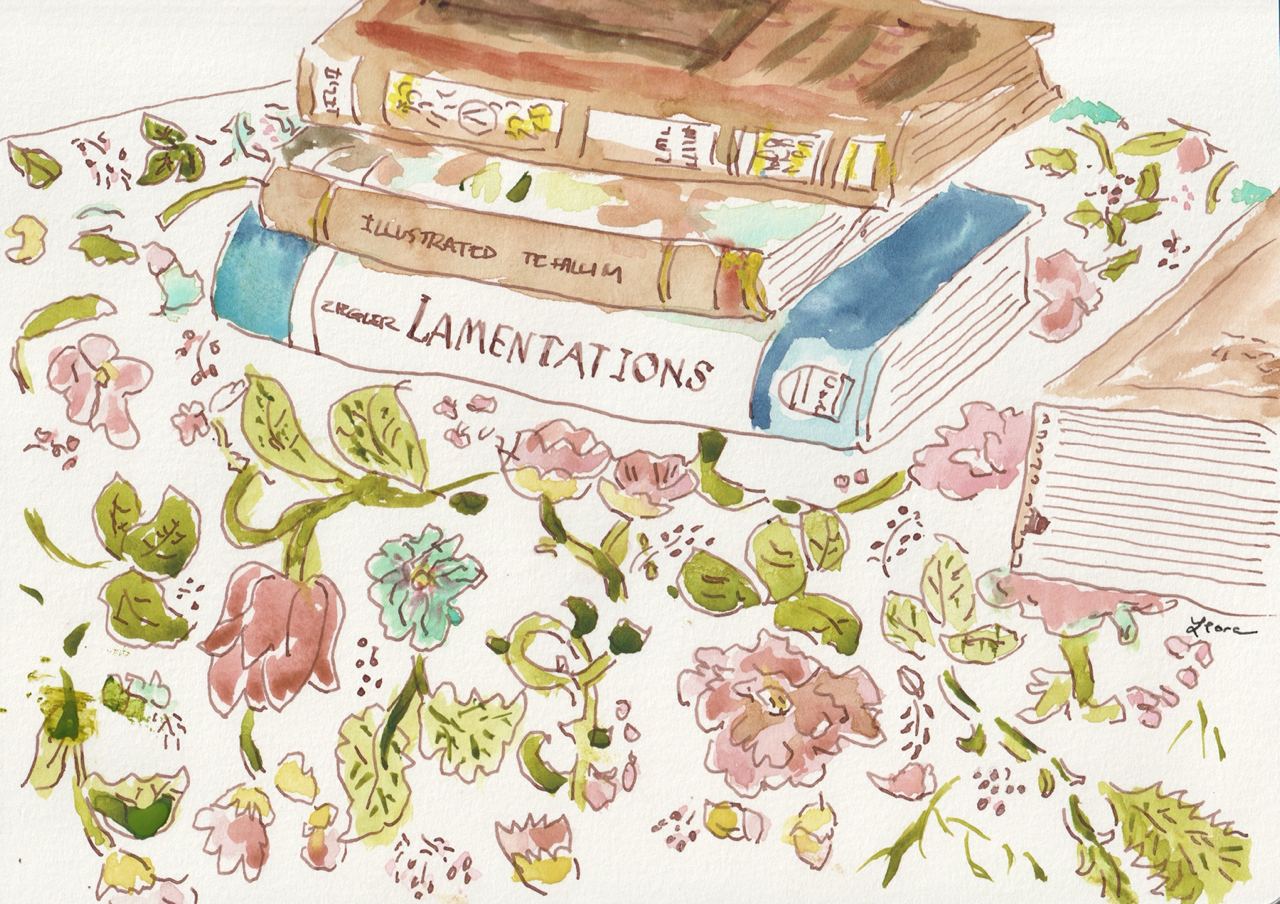
A few weeks later, I painted these books on the same patterned fabric. It was in response to the theme of PATTERNS, an instagram challenge. I was able to pay careful attention to the details in part because I knew people on Instagram would be looking at the painting. I have emotional attachment to the fabric, as it was a purchase by my mother z”l.
The book of Illustrated Tehillim was given to me by my mother-in-law, as she knew I was looking for pictures of tehillim. Lamentations, the English name for the megillah of Eicha, is a book I am reading by Yael Ziegler, a wonderful speaker who I have met in person. Read it if you want a detailed, scholarly, and poetic approach to reading Eicha. I did this painting right after Tisha B’Av, the week we read parshat Nachamu, about comfort (Isaiah 40:1):
נַחֲמ֥וּ נַחֲמ֖וּ עַמִּ֑י יֹאמַ֖ר אֱלֹֽהֵיכֶֽם׃
Comfort, oh comfort My people,
Says your God.
Those books rest under Devarim, the parshiot we are reading now at this time of the summer.

































